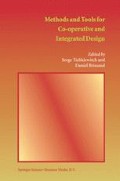Abstract
During product development process, several tasks have to be carried out in order to progressively map a set of functions (requirements) to a technological structure. This structure is then designed taking into account a certain number of constraints related to the whole product life cycle (materials, structural analysis, recycling, etc.). In such a context of concurrent engineering this paper focuses on the manufacturing constraints that should be analysed and integrated (synthesis) in the product development. The results then describe what could be the methodology and the model to do so. This work is strongly linked to already-accepted concepts of the scientific community. Indeed, some results on manufacturing process selection exist. Nevertheless they can only be applied once the product form features totally identified. As far as integration is concerned, a lot of product models have also already been proposed in the scientific community, our proposal addresses an evolution of those models toward our manufacturing integration problem. A common model has been specified to link product modelling and manufacturing knowledge modelling. This model is based on an evolution of skin and skeleton concepts. Those concepts have been introduced in many papers for specific points of view modelling but not ever used for manufacturing process selection and integration. Those concepts have been linked to a methodology of selection and integration that can be used at different stages of design process as soon as the first technological choices are realised. Several steps of the proposed methodology are based on manufacturing information management. A structure of this information has then been specified. First, multiple points of view information (functional, structural, structural analysis, etc.), and then manufacturing process information are mapped to the common concepts (skin and skeleton) in order to couple the proposed design solutions to available ones for manufacture.
Access this chapter
Tax calculation will be finalised at checkout
Purchases are for personal use only
Preview
Unable to display preview. Download preview PDF.
References
Kjelberg T., Scmelkel H., Product Modelling and Information Integrated Engineering Systems, Annals of the CIRP, vol. 41, n°1, pp 201–204, 1992.
Krause F.L., Kimura F., Kjelberg T., Lu S.C-Y., Product modelling, Annals of the CIRP, vol. 42, n°2, pp 695–706, 1993.
Anderl R., Mendgen R., Modelling with constraints: theoretical foundation and applications, Computer Aided Design, Vol. 28, n°3, pp 155–166, 1996.
Tichkiewitch S., Specification on integrated design methodology using a multi-view product model, ESDA Proceedings of the 1996 ASME System Design and Analysis Conference, PD-Vol. 80, 1996.
Molina A., Bell R., Reference models for the computer aided support of simultaneous engineering, International Journal of Computer Integrated manufacturing, vol. 15, n°3, 193–213, 2002.
Salomons O.W., Popma M., Houten F.J.A.M. van, What-If synthesis support tools as a new paradigm in CAD, proceedings of TMCE 2000 conference, Delft, April, pp. 169–182, 2000.
Boothroyd G., Dewhurst P., Knight W., Product design for manufacture and assembly, Marcel Dekker, pp 1–29, New York, 1994, ISBN 0–8247–9176–2.
Ashby M.F., Materials selection in mechanical design, ISBN 0 7506 4357 9, 1999.
Lovatt A.M., Shercliff H.R., Manufacturing process selection in engineering design; part1: the role of process selection, Material and Design, volume 19, pp 217–230, 1998.
Lovatt A.M., Shercliff H.R., Manufacturing process selection in engineering design; part2: the role of process modelling, Material and Design, 2001.
Tichkiewitch S., Roucoules L., Innovative design methodology; Integration of process Knowledge into Design Support (Kluwer Academic Publishers). ISBN 0–7923–5655–1, pp. 79 – 88, 1999.
Badham R., CAD/CAM and human centred design, Science and technology analysis research programme, working paper n° 6, April 1991.
Wu M-C., Wu T.Y., A skeleton approach for modelling assembly products, Journal of Design and Manufacturing, n°3, pp 121–133, 1993.
Tollenaere M., Belloy Ph., Tichkiewitch S., A part description model for the preliminary design, Advanced CAD/CAM Systems - State-of-the-art and future trends in feature technology, pp 129–143, Chapman & Hall, Ed. Soenen, 1995.
Roucoules L., Salomon O, Paris H., Process planning as an integration of knowledge in the detailed design phase, International Journal of Computer Integrated Manufacturing, Vol. 16, N°1, pp. 25–37, 2003.
Mari J.L., Sequeira J., Reconstruction by implicit surfaces using discrete and continuous skeletons, Revue Internationale d’Informatique Graphique et de CFAO, Volume 16: n°2, pp. 203–212, 2001.
Miao H.K.., Sridharan N., Shah J., CAD-CAM integration using machining features, International Journal of Integrated Manufacturing, Vol. 15, n°4, 296–318, 2002.
Paris H., Brissaud D., Modelling for process planning: the links between process planning entities, Robotics and Computer-Integrated Manufacturing, 16 (4), 259–266, 2000.
Ermine J.L., Waeters A., Knowledge Management and Capitalisation as a support for innovation, Human Centered Process, 11th World Productivity Congress WPC’99, Edimburg, 1999.
Author information
Authors and Affiliations
Editor information
Editors and Affiliations
Rights and permissions
Copyright information
© 2004 Springer Science+Business Media Dordrecht
About this paper
Cite this paper
Roucoules, L., Skander, A. (2004). Manufacturing Process Selection and Integration in Product Design. In: Tichkiewitch, S., Brissaud, D. (eds) Methods and Tools for Co-operative and Integrated Design. Springer, Dordrecht. https://doi.org/10.1007/978-94-017-2256-8_7
Download citation
DOI: https://doi.org/10.1007/978-94-017-2256-8_7
Publisher Name: Springer, Dordrecht
Print ISBN: 978-90-481-6536-0
Online ISBN: 978-94-017-2256-8
eBook Packages: Springer Book Archive

